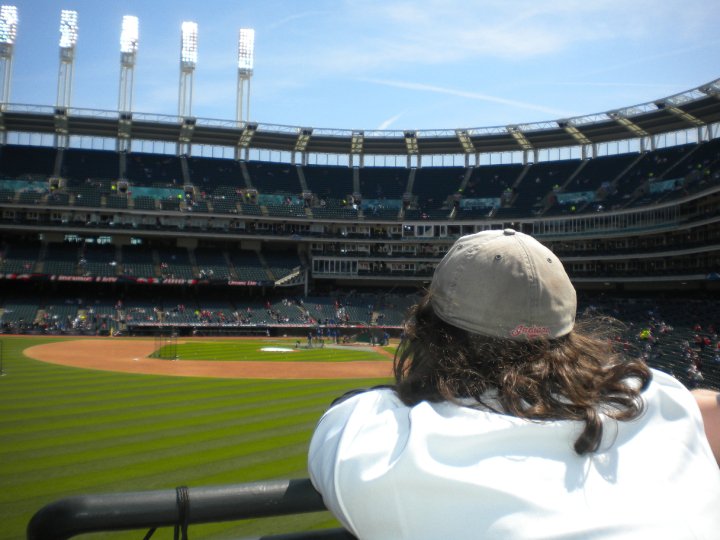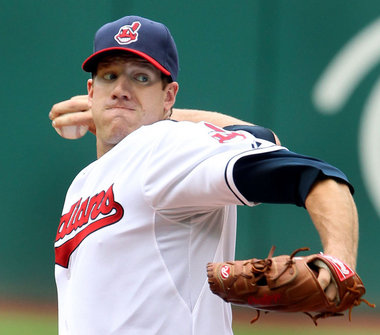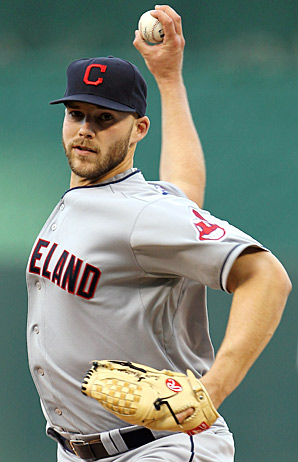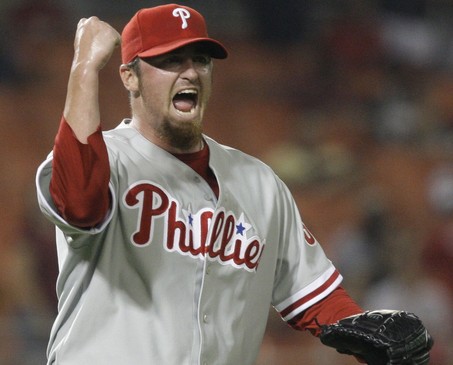 Indians Archive
Indians Archive  View from the Porch: An Evaluation of the Starting Rotation
View from the Porch: An Evaluation of the Starting Rotation
 All of the reports coming out of Spring Training tell a tale of an excited team, fired up by an offseason that included the acquisitions of Nick Swisher, Mark Reynolds, Michael Bourn, and Terry Francona. Playing the roles of Debbie Downer, Wet Blanket, Facepalm, Whiskey-Tango-Foxtrot, and Swift Kick in the Genitals are the starting pitchers. The assumption is that the starting rotation will be what prevents the Indians from having the ability to contend for a playoff spot. On paper, it’s certainly not an impressive list, especially with two of the five spots currently unaccounted for, and the three spots that are accounted for are leaving us with the same sense of security that a small child left alone in a room with a rabid Rottweiler would have.
All of the reports coming out of Spring Training tell a tale of an excited team, fired up by an offseason that included the acquisitions of Nick Swisher, Mark Reynolds, Michael Bourn, and Terry Francona. Playing the roles of Debbie Downer, Wet Blanket, Facepalm, Whiskey-Tango-Foxtrot, and Swift Kick in the Genitals are the starting pitchers. The assumption is that the starting rotation will be what prevents the Indians from having the ability to contend for a playoff spot. On paper, it’s certainly not an impressive list, especially with two of the five spots currently unaccounted for, and the three spots that are accounted for are leaving us with the same sense of security that a small child left alone in a room with a rabid Rottweiler would have.
But, is it really that bad? Many in the baseball community believe that the Indians rotation is something that would come out of the backside of the aforementioned Rottweiler. That group includes media members, stat geeks, and, well, pretty much everybody who has an opinion on baseball. The biggest issue with the starting rotation is the top of it. As #1 and #2 starters, Justin Masterson and Ubaldo Jimenez fall under the category of mediocre-to-awful. As a #3 starter, Masterson would be viewed as an asset, and probably slightly above average. Jimenez’s reputation in the baseball community may be beyond repair at this point.
There’s no way around the fact that the Indians do not stack up with the other American League teams at the top of their rotation. They don’t necessarily need a Justin Verlander or Felix Hernandez, but, they need somebody to rely on, who can at least play the role of an ace periodically. That pitcher, currently, does not exist.
With the offseason upgrades to the lineup, the Indians’ rotation will have to be good (for their standards), but not great, for the team to have a chance at sneaking into the playoffs, especially with the benefit of the second wild card. Everybody points to the 2012 season, where the rotation was historically bad, as what to expect again in 2013. Personally, I don’t see that as the case.
This group will be better in 2013. Will it improve enough to make September interesting? That’s a question that they’ll have to answer. They should be operating with a greater margin for error after pitching for the second-worst offense in terms of run scoring in the American League last season. The Indians entered the fifth inning trailing on the scoreboard in 86 of their 162 games. They were 13-73 in those games. They were 44-10 when they had a lead entering the fifth inning. When the Indians got a good start, they won more often than not. The problem was that they didn’t get many good starts.
It’s not easy to pitch knowing that if you give up four runs, your team will lose. The Indians were 19-83 last season when they allowed four or more runs. Adding extra pressure by never pitching with a lead or knowing that one mistake will cost your team the game is extremely difficult and a lot to ask of a starting staff. Add in that the Indians had the third-youngest pitching staff in baseball and, by the end of the season, the starters’ ages were 27, 28, 24, 24, and 26. Add in that Indians pitchers had a terrible defense behind them, one that allowed 79 unearned runs and countless other runs by a lack of range or other miscues that weren’t counted as errors.
I’ve painted a nice picture, haven’t I? How could I possibly be optimistic about this group? I’ll admit that it’s not easy. I don’t think I can put enough lipstick on this pig to make it pretty, but there’s a chance that the Indians rotation could at least be around league average, which could give them a shot at October. There are some positive trends to focus on. The guys that won’t pitch for the Indians this season didn’t give them anything of value last season and the guys who will see an increased role should be an upgrade over those pitchers.
The overall numbers for the starters in 2012 were ugly: 48-76, 5.25 ERA, 1.51 WHIP, and a 4.73 FIP. What the difference between ERA and FIP, fielder independent pitching, tells us is that the Indians defense was bad and the pitchers suffered because of it. Well, it also tells us that the pitchers weren’t very good in their own right, but that the fielders didn’t help either. To reiterate what goes in to the calculation of FIP, it is a metric that creates an alternative to ERA using outcomes that the pitcher has exclusive control over – home runs, walks, hit by pitches, and strikeouts. A 4.73 FIP is not good, nor is a 5.25 ERA.
Now, let’s re-calculate those numbers without Josh Tomlin, Derek Lowe, Jeanmar Gomez, David Huff, Roberto Hernandez, and Chris Seddon, six guys who will not make any starts for the Indians this summer. Huff is the only one with an outside shot, but I’d put it at less than five percent that he makes a start. Lowe, Gomez, Hernandez, and Seddon are on other teams and Tomlin is out for the season rehabbing from Tommy John surgery.
 That leaves Justin Masterson, Ubaldo Jimenez, Zach McAllister, and Corey Kluber: 28-45, 4.94 ERA, 1.49 WHIP, 4.47 FIP. Not good, but better. If you’ll recall my latest article, Thursday’s look at the Indians possibly being 2013’s Baltimore or Oakland, a 4.47 FIP would have ranked higher than Baltimore’s 4.50 FIP. It’s important to understand what these numbers mean and what they could mean for the Indians.
That leaves Justin Masterson, Ubaldo Jimenez, Zach McAllister, and Corey Kluber: 28-45, 4.94 ERA, 1.49 WHIP, 4.47 FIP. Not good, but better. If you’ll recall my latest article, Thursday’s look at the Indians possibly being 2013’s Baltimore or Oakland, a 4.47 FIP would have ranked higher than Baltimore’s 4.50 FIP. It’s important to understand what these numbers mean and what they could mean for the Indians.
In terms of sample size, Masterson and Jimenez accounted for over 40 percent of the starts overall and nearly 66 percent of the starts in the second set of numbers. Masterson certainly had a tough year, with a spike in walks and a major spike in home runs allowed. Jimenez built off of his 2011 performance and sucked again in 2012.
My optimism for the rotation comes from Zach McAllister and Corey Kluber. I won’t know for sure if I’m right or not until much later in Spring Training, but my gut instinct is that both McAllister and Kluber make the Opening Day rotation. The fourth and fifth spots are an open competition between McAllister, Kluber, Trevor Bauer, Carlos Carrasco, Scott Kazmir, and Daisuke Matsuzaka. I’m assuming that Bauer heads to Columbus to work on his command problems and ensure the Indians another year of contractual control by bringing him up sometime in late June. Carrasco is supposedly pitching without limitation, 18 months removed from Tommy John surgery, but he will have some rust and the Indians will probably want to ease him back into pitching every five days in Columbus’s low-stress environment. Kazmir and Matsuzaka have to prove something to me and the Indians, with both having rebuilt arms and no Major League success for quite some time.
There are a lot of reasons to like McAllister and Kluber. McAllister’s 7.9 K/9 was the highest of any Indians rookie since CC Sabathia in 2001. Kluber, in a smaller sample size, posted a 7.71 K/9. League average tends to be around 7.1 K/9. Along with missing bats, McAllister and Kluber both issued a below average number of walks. McAllister issued 2.73 walks per nine innings and Kluber checked in at 2.57. The league average for BB/9 tends to be around 3.3 walks per nine innings. From a command standpoint, both of these guys showed a good knowledge of the strike zone last season, something that’s usually difficult for young pitchers. McAllister threw 60.8 percent of his first pitches for strikes and Kluber lead the team in swinging strike percentage at 10.7. McAllister was second at 8.3 percent
The biggest problem for both guys was the long ball. McAllister allowed 19 in just over 125 innings and Kluber allowed 9 in 63 innings.
There are a lot of positive trends to be excited about and both guys were getting their first extended time in the Majors. McAllister was really good early and trailed off late in the year, posting ERAs above 5.00 in both August and September/October, along with a spike in walks. It’s likely that McAllister just got tired, throwing a career high of 188.2 innings between Columbus and Cleveland. All in all, it was a hell of a season for the 24-year-old, who made big strides and got some important experience.
To me, McAllister and Kluber are as important to this rotation as getting Masterson and Jimenez right. Again, I don’t know if Kluber will make the rotation. McAllister has “an inside track” on a rotation spot according to MLB.com Indians beat writer Jordan Bastian. If Kluber doesn’t make the rotation, it’s because somebody out-performed him in Spring Training, which can’t be a bad thing, and he would be a good depth option in case of an injury or ineffectiveness.
 But the two elephants in the room are definitely Masterson and Jimenez. We found out last season that 2011 was likely Justin Masterson’s aberration. In 2011, he had a 3.21 ERA, a 3.28 FIP, only walked 2.71 batters per nine innings, gave up just 11 home runs in 216 innings, and gave us all hope that he was morphing into a good #1 starter. The 2012 season brought us all back to Earth.
But the two elephants in the room are definitely Masterson and Jimenez. We found out last season that 2011 was likely Justin Masterson’s aberration. In 2011, he had a 3.21 ERA, a 3.28 FIP, only walked 2.71 batters per nine innings, gave up just 11 home runs in 216 innings, and gave us all hope that he was morphing into a good #1 starter. The 2012 season brought us all back to Earth.
The almost 0.8 run difference between Masterson’s ERA (4.93) and FIP (4.16) signals that he wasn’t nearly as bad as his ERA shows. He was the biggest victim of the below average defense, specifically on the infield. In the stats that Masterson needs to have consistency in, he did, posting a 6.94 K/9 rate, pretty close to his 7.07 career K/9 rate. His ground ball percentage of 55.7 percent was right near his career rate of 56 percent. Of the 18 home runs Masterson allowed, just six were of the solo variety, which really hurt him and was where the walks and questionable defense came into play. Masterson threw more first pitch strikes in 2012 than he did in 2011 and also induced more swings and misses.
Another thing that affected Masterson, probably more than we ever knew, was that Manny Acta showed him what some people would call tough love and what others would call a complete lack of respect. Masterson gave up six or more runs nine (!!) times out of his 34 starts. In seven of those starts, Acta left him out there to throw 89 or more pitches and serve as a sacrificial lamb. It was reported that Acta’s treatment of Masterson rubbed some players the wrong way and was part of the reason why the team seemed to quit on Acta.
It was a tough year all around for Masterson. With Francona now the manager, who Masterson is very familiar with from their Boston days, the slate is clean for Masterson. That, in and of itself, could lead to some improvement.
Talking about Ubaldo Jimenez is just depressing. When the trade was made, I loved it. To date, Drew Pomeranz has not become the starter that the Rockies were expecting and Alex White was traded to Houston. It has been a lose-lose for both teams, yet it was a gamble that both organizations needed to take. Sometimes things just don’t work out, no matter how smart they seem.
Last year, in my 2012 season preview, I tried to argue how Jimenez’s FIP indicated that he should be better and that his 2011 season looked like an outlier. Then, as his velocity continued to drop, he threw the ball in the direction of home plate like the neighborhood drunk throwing darts just before last call, and was a mechanical mess.
In a season full of terrible trends for Jimenez, the worst one, in my opinion, was the severe drop in ground ball rate. Jimenez was a ground ball machine from 2007-2011, with yearly ground ball rates of 46.4, 54.4, 52.5, 48.8, and 47.2. The league average is 44 percent. In 2012, Jimenez’s ground ball rate fell to 38.4 percent.
As believers in the ground ball like to say, you can’t hit a home run on a ground ball. Not surprisingly, Jimenez saw the highest HR/9 rate of his career at 1.27 and the highest HR per fly ball rate of his career at 11.8 percent. Keep in mind that he allowed more fly balls than in any other year of his career and HE USED TO PITCH AT COORS FIELD! Oh, yeah, and he also allowed the highest line drive rate of his career….by nearly four percent.
So, to summarize, we have a pitcher who is losing velocity, with no control, who is regularly pitching up in the zone and not fooling anybody, posting the lowest swinging strike percentage of his career. The worst part about all of this is that these weren’t new developments in 2012. This entire process was already developing when the Indians acquired Jimenez. Despite the clear red flags, the Indians rolled the dice anyway. And they threw snake eyes.
I’m not saying Jimenez can’t be fixed, though I wouldn’t hold my breath about it. In spite of Jimenez’s bad showing after the trade and horrid 2012, the Indians picked up his option for 2013. I hope they know something we don’t, but I don’t see it from a statistical analysis perspective.
 Another wild card in the rotation is Brett Myers. Myers spent last season as a reliever and was effective over 70 appearances, posting a 3.31 ERA. Myers was a starter in 2011, posting a 4.46 ERA and a 4.26 FIP, both below average, in the National League with the Astros. Projecting Myers seems to be difficult, as he has a track record of being an innings eater with average numbers, but he has never started in the American League. The hope would be that he stays healthy and gives consistent starts, but expectations should be kept fairly low.
Another wild card in the rotation is Brett Myers. Myers spent last season as a reliever and was effective over 70 appearances, posting a 3.31 ERA. Myers was a starter in 2011, posting a 4.46 ERA and a 4.26 FIP, both below average, in the National League with the Astros. Projecting Myers seems to be difficult, as he has a track record of being an innings eater with average numbers, but he has never started in the American League. The hope would be that he stays healthy and gives consistent starts, but expectations should be kept fairly low.
What does that leave us with? Well, it leaves us with a rotation that shouldn’t be as bad as 2012, but will struggle to be near league average as a group. A below average starting rotation could be the Achilles’ heel to an above average lineup and an above average bullpen. The Indians could get reinforcements later in the season from Bauer and Carrasco, and possibly even Kluber if he doesn’t make the Opening Day roster, so the talent level could go up in the second half of the season and may help the playoff push, if there is one.
Basically, the plan seems to be to try and hang around in the game for the first five or six innings and see what happens when the game gets into the bullpens. The Indians should have a stronger bullpen than most opponents and are tough to matchup against in the late innings, with three switch hitters, some players with good platoon splits, and some positional versatility that will keep them strong defensively if players are lifted for pinch hitters or pinch runners.
The Indians improved the lineup, the defense, and the depth of the bullpen this offseason, but the starting rotation is a major cause for concern.
- NBA Announces 2013-2014 Schedule
- Browns Ink Sharknado
- Sharknado A No-Show For Rookie Camp
- Trent Richardson Out Until Training Camp
- Browns Sign Brandon Jackson
- Carrasco Suspended Eight Games
- Browns Add to Wide Receiver Depth with David Nelson
- Browns Need to Learn from Past Draft Mistakes
- Browns Release Chris Gocong and Usama Young
- Browns Missing on Grimes Disappointing, But Not The End
The TCF Forums
- Chris Grant's first 3 drafts
Kingpin74 (Tuesday, January 21 2014 10:13 AM) - The 2014 Offseason Thread
googleeph2 (Tuesday, January 21 2014 9:36 AM) - 2015 Recruiting
furls (Tuesday, January 21 2014 6:57 AM) - Mike Brown
YahooFanChicago (Monday, January 20 2014 11:15 PM) - Movies coming out
HoodooMan (Monday, January 20 2014 9:34 PM) - 2014 Hoops Hockey Hijinx
jpd1224 (Monday, January 20 2014 4:44 PM) - 2014 Recruiting
jclvd_23 (Monday, January 20 2014 2:26 PM) - Wish List - #4 Pick
Hikohadon (Monday, January 20 2014 1:26 PM) - Official- Browns Coach Search/Rumors
OldDawg (Sunday, January 19 2014 6:48 PM) - #1 overall pick Anthony Bennett
TouchEmAllTime (Sunday, January 19 2014 1:28 PM)


